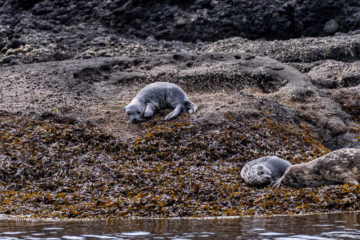by David Greer

Camera in hand, nature photographer Myles Clarke walked along the pebble beach on South Pender Island watching for great blue herons, bald eagles, buffleheads, cormorants—any of the species likely to frequent waters close to the shore of a Salish Sea island on a summer’s day. He listened carefully for their familiar calls, but what he heard instead was plaintive cries unlike any bird’s, eerily like a child crying for its mother—“Ma-a-a! Ma-a-a!” Inexplicably, they seemed to be coming from the direction of a tiny islet in the bay, a hundred yards from shore, not the kind of place you’d expect to find a crying infant.
The source of the calls was indistinct against the black rock, so Myles pointed his 600 mm telephoto lens for a better look. What he saw was fascinating and unsettling. Three harbour seals were hauled out on the islet—a mother and her newborn side by side and, several feet away, a second pup, the source of the loud and piteous cries.
On return visits the next couple of days, Myles became increasingly concerned that the crying seal was in trouble. It seemed to approach mothers of other pups (there were several by now) as if attempting to suckle, and on each occasion the adult would chase the crying pup away and open its jaws as if threatening to bite. On the third day, the pup seemed to have become weaker and its cries fainter. Read more »
